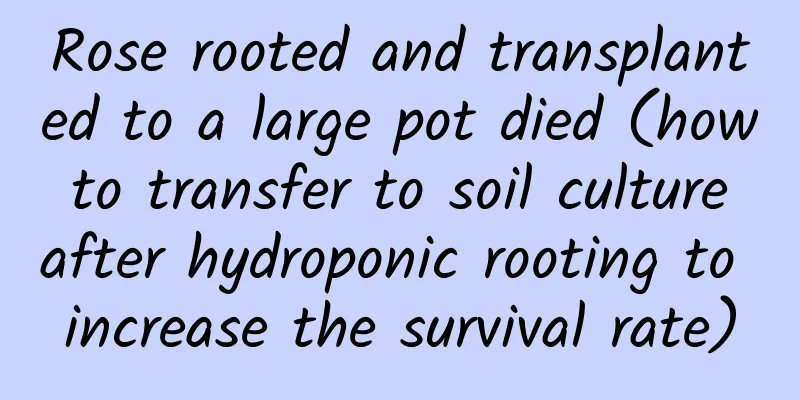Rose rooted and transplanted to a large pot died (how to transfer to soil culture after hydroponic rooting to increase the survival rate)

Why did the rose die after taking root and transplanting it into a large pot?There are six reasons why rooted roses die after transplanting: the soil after transplanting is not suitable; the root system has not grown well; the root system is damaged during the transplanting process; the base fertilizer is added to the transplanted seedlings and burns them; the rooting water is not poured thoroughly; other conditions such as temperature are not suitable. ①The soil used is half sand and half soilRoses like loose soil. Sandy soil is very hard. Sand is too permeable, so the rose roots cannot absorb water. This kind of soil dries up quickly after watering. It is too permeable, so roses are prone to die just after transplanting. How many jasmines and gardenias died because the soil was compacted, their roots could not breathe, and they were not watered thoroughly. The rose's young roots are particularly fragile and are not suitable for growing in this kind of soil. It is recommended to use peat soil + humus soil + coconut bran + vermiculite + perlite, with a ratio of about 2:3:2:2:1 . The soil is loose and nutritious. Vermiculite is good for rooting, and many rose growers use vermiculite for cuttings. ②The rose root system is too weakIf you plant rose cuttings in a paper cup and use sandy soil, you can't see how the roots are growing. If the soil has a lot of sand, it will fall off easily during the transplanting process, and the weak roots will be injured. If there is a lot of mud and the soil is compacted, the roots will not be strong. Most flower lovers are very happy at the beginning when their cuttings are successful and they have roots. They transplant the plants to large pots when the roots are still tender. At this time, the root system is too weak and has not grown well, so they are transplanted to large pots. They cannot adapt and die. ③ Transplantation damages the root systemMany flower lovers are so excited to see the roses from cuttings survive that they use too much force and break the roots. There is also a situation where the soil of the cuttings is removed during transplanting, damaging the roots in the process. ④ Add base fertilizer after transplantingThe roots of newly transplanted roses are very tender and weak, and their demand for fertilizer is not as much as everyone thinks. There is no need to add base fertilizer. The fertilizer in the soil itself is enough for the seedlings to grow. After the seedlings have finished acclimatizing, you can add fertilizer and irrigate the roots. Don't force the growth! ⑤ The rooting water is not watered thoroughlyNewly transplanted rose seedlings must be watered thoroughly after planting to allow all the roots of the rose to fully contact the soil so that the seedlings can grow well. Otherwise, the roots will have no support and will soon die. ⑥Temperature problemIf the temperature is too high during transplanting, the rose will not be able to recover easily and may die easily. 【 Summarize 】 When planting rose seedlings, you should first use soil that is easy to root. After the root system grows vigorously and the roots are a little older, you can transplant them. The soil for planting seedlings should be loose but also able to fix the roses and have good drainage. When planting rose seedlings, be careful not to damage the roots. Do not fertilize the soil in the early stage. After planting, place it in a ventilated and cool place to slow down. |
>>: Can potassium dihydrogen phosphate be used for roses (what fertilizer is best for potted roses)
Recommend
How to grow the green treasure tree in winter
1. Breeding methods: 1. Temperature: People in th...
How to prune small-leaf boxwood
Pruning time of boxwood In the spring, the small-...
How to plant butterfly flower seeds
The seeds of Cleome are generally harvested in Se...
Diseases and Pests of Plane Flower and Their Control
Diseases of Plane Flower Leaf spot and powdery mi...
What are the cultivation methods and precautions for succulent plants?
Succulent plant growth habits Succulent plants pr...
How long does it take for Phoenix bamboo to adapt to the pot?
The time for the Phoenix bamboo to adapt to the p...
Rice planting and harvesting time
Rice planting time The planting time varies great...
How to deal with root rot of lucky bamboo
1. Hydroponics 1. Take out the plant and use ster...
Can water lilies be cultivated hydroponically? What are the cultivation methods and precautions for hydroponically cultivated water lilies?
Can pink palm be hydroponically cultivated? Pink ...
How to repot a fiddle-leaf fig and how to acclimate after repotting
1. How to change the pot 1. Time: It is recommend...
When is the best time to prune hydrangeas?
Pruning of hydrangea Pruning hydrangeas can reduc...
How often should I water the gardenia?
Since gardenia is a plant that is not tolerant to...
Diseases and Pests of Impatiens and Their Control
Diseases and their control of Impatiens africana ...
Yew seedlings price, yew pictures
1. Seedling price The uses of yew are quite wide....
Where is the best place to grow chives? What are the best environmental conditions for growth?
Leek planting area Chives are suitable for planti...









